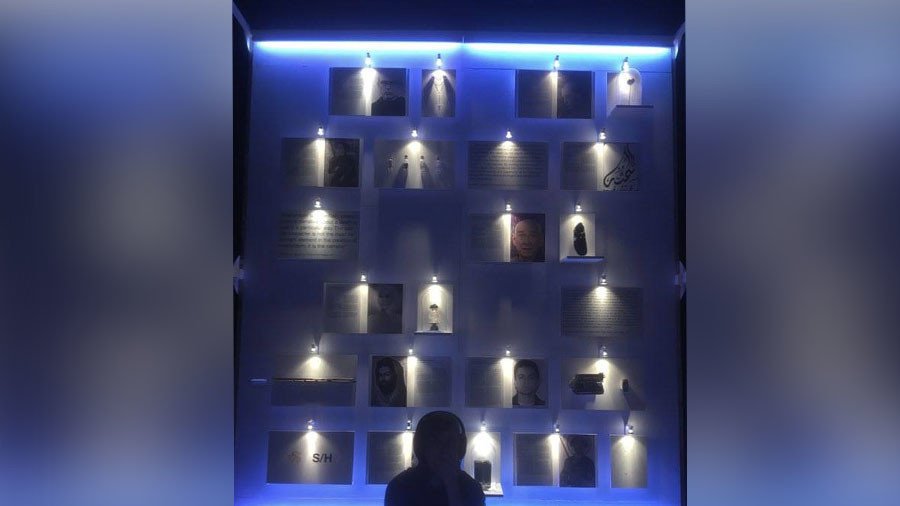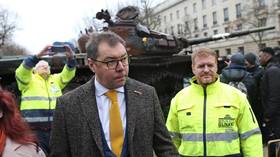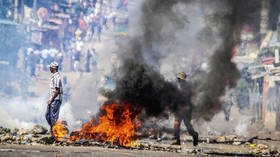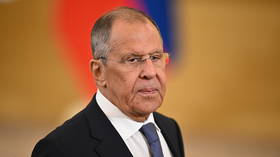Exhibit portraying terrorists as ‘martyrs’ comes to Berlin, causing outcry

A Danish art group brought its controversial exhibition dedicated to history’s martyrs to Berlin. The public appears to not have appreciated the idea of terrorists being put in the same company with rights activists or even saints.
An exhibition called “Martyrs’ museum” opened this week in Berlin’s Bethanien exhibition hall. It offers its visitors what it calls an opportunity to look at the history of martyrdom in an “absolutely unbiased” way.
An interactive show of sorts, it features images of people, who “sacrificed their lives to their cause” throughout history, as well as replicas of objects associated with a given figure. The installation also involves light and sound effects meant to help visitors delve into the issue.
However, alongside such prominent historical figures as the ancient Greek philosopher Socrates, the US civil rights activist Martin Luther King or even early Christian Saint Apollonia, the exhibit also features images of modern terrorists, who died while carrying out attacks that claimed the lives of thousands of people in total.
The installation particularly tells the stories of Mohammed Atta, who deliberately crashed a plane into one of the twin towers of the World Trade Center in the New York City on September 11, 2001, as well as that of Ismael Omar Mustafa, who was among those shooting people at the Bataclan club in Paris in November 2015.
The list of terrorists, who are presented at the exhibition as “martyrs, who died for their cause,” also includes the attackers who devastated Brussels in March 2016, and a suicide bomber who blew herself up in the Moscow metro in 2010. The organizers also offer the visitors audio guides that “tell the stories” of the “martyrs,” particularly explaining that the terrorists saw their actions as a fight against western culture or for the independence of their homelands.
“The artists sought to broaden the concept of martyrdom,” Ricarda Ciontos, the person managing the Nordwind Festival that hosts the exhibition, told the local media. “A notion of a martyr is understood and used by us and other countries in an absolutely different way,” she said, adding that, such countries as Iraq or Iran glorify those, whom the west sees as murderers and terrorists.
The idea of martyrdom is highly dependent on a relevant context, Henrik Grimbaeck, one of the artists who organized the exhibition, told the daily Die Welt. Ultimately, a martyr is someone who declares himself a martyr, he added, explaining that the exhibit is actually aimed at “bringing people together.”
Many people apparently do not share these views, with most of them horrified by the idea of terrorists being equated to civil rights activists, and those who sacrificed their lives in Nazi concentration camps to save others.
“An “art” exhibition in Berlin’s Kreuzberg [district] glorifies Islamist mass murderers!” one person wrote on Twitter as people turned to social media to voice their discontent and indignation over the controversial installation. He also wondered, “what the Berlin mayor’s office thinks about it.”
“Kunst”#Ausstellung in #Berlin Kreuzberg verherrlicht islamistische Massenmörder. Wie steht die Berliner @Senatskanzlei_B dazu? https://t.co/PhmZm4WomX
— Götz Frömming, MdB (@GtzFrmming) November 30, 2017
“Bataclan murderer presented as a martyr with the help of the public funds? Is it really the Germany, in which we live well and feel good?” another person asked, referring to the German Chancellor Angela Merkel’s election slogan.
Bataclan Mörder mit öffentlicher Förderung als Märtyrer präsentiert ?Ist das das Deutschland, in dem wir gern und gut leben ? 🤢 https://t.co/rVxohnnLip
— Calgacus (@beauregard_ii) November 30, 2017
“They have sympathy for the murderers but no compassion for their victims. Now, this is Germany,” one more person wrote, apparently referring to the exhibition organizers.
#Berlin: Man hat Sympathien für Mörder und kein Mitleid mit den Opfern. Jetztzeit in Schland. https://t.co/blqFJNTSyG
— MaWiHo (@Meckerschwabe) November 30, 2017
“Is Art allowed to mock thousands of victims? No – even Art has its limits: human dignity and humanism,” another wrote in a Twitter post.
Darf #Kunst Tausende Opfer verhöhnen? Nein - auch in der Kunst gibt es Grenzen: menschlicher Anstand und Humanität https://t.co/Uf623CBu6O
— Ulrich Soénius (@Ulrich_Soenius) November 29, 2017
Some people argued that the word “controversial” is apparently not enough to properly describe this exhibit. “Controversial? That is an insult [to the memory] of the victims. Sympathies to Islamic State (IS, former ISIS). So appalling for Germany,” one person wrote.
🥁umstritten???Das ist eine Verachtung der Opfer.Eine Sympathi des IS.Erbärmlich für Deutschland. https://t.co/GquQ3ejuCQ
— Fritz (@A_Hildering) November 30, 2017
Many people also accused the exhibition organizers of advocating the views of terrorists while others were so angry with the installation that they slammed the artists, who organized it, in the strongest of words.
The popular uproar even prompted the local council to officially declare that it has nothing to do with the exhibition and that it has never supported it in any way. Some media reports suggested earlier that the installations could have been supported by public funds managed by the council.
The exhibition was organized by the Danish artist collective The Other Eye of the Tiger that earlier held a similar installation in Copenhagen. At that time, the provocative exhibit prompted a local politician to call the police to deal with an “incitement to public violence”. According to some reports, the Danish security services dealing with terrorist threats also investigated the actions of the artist group.













